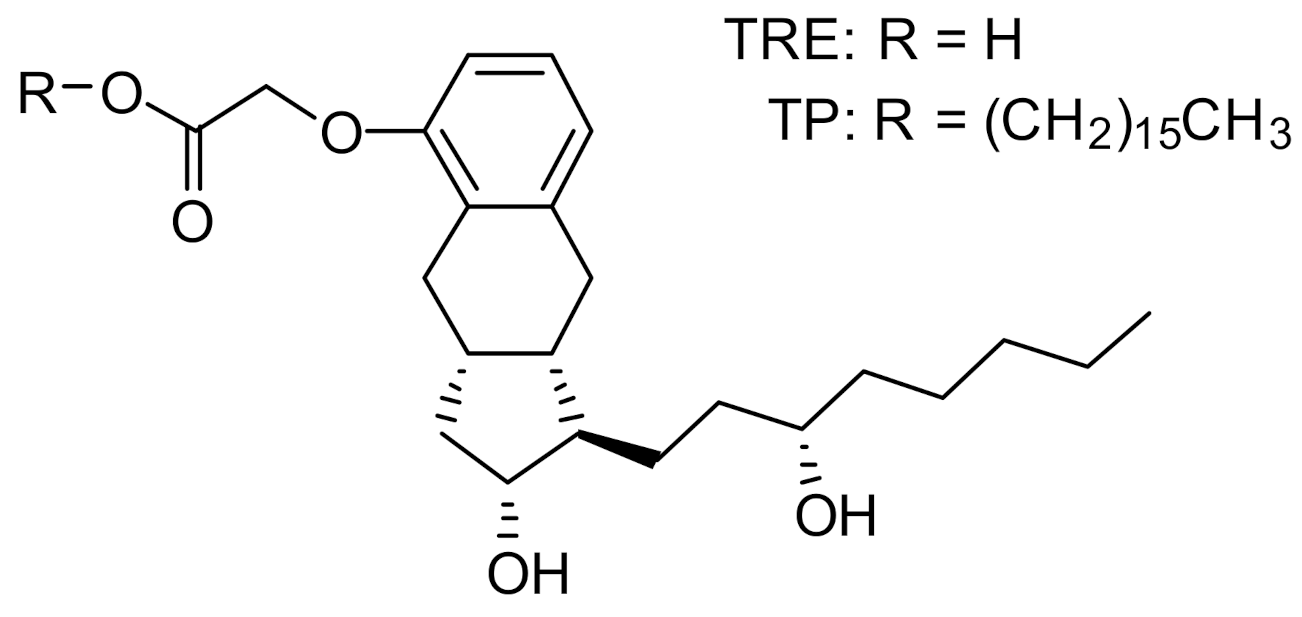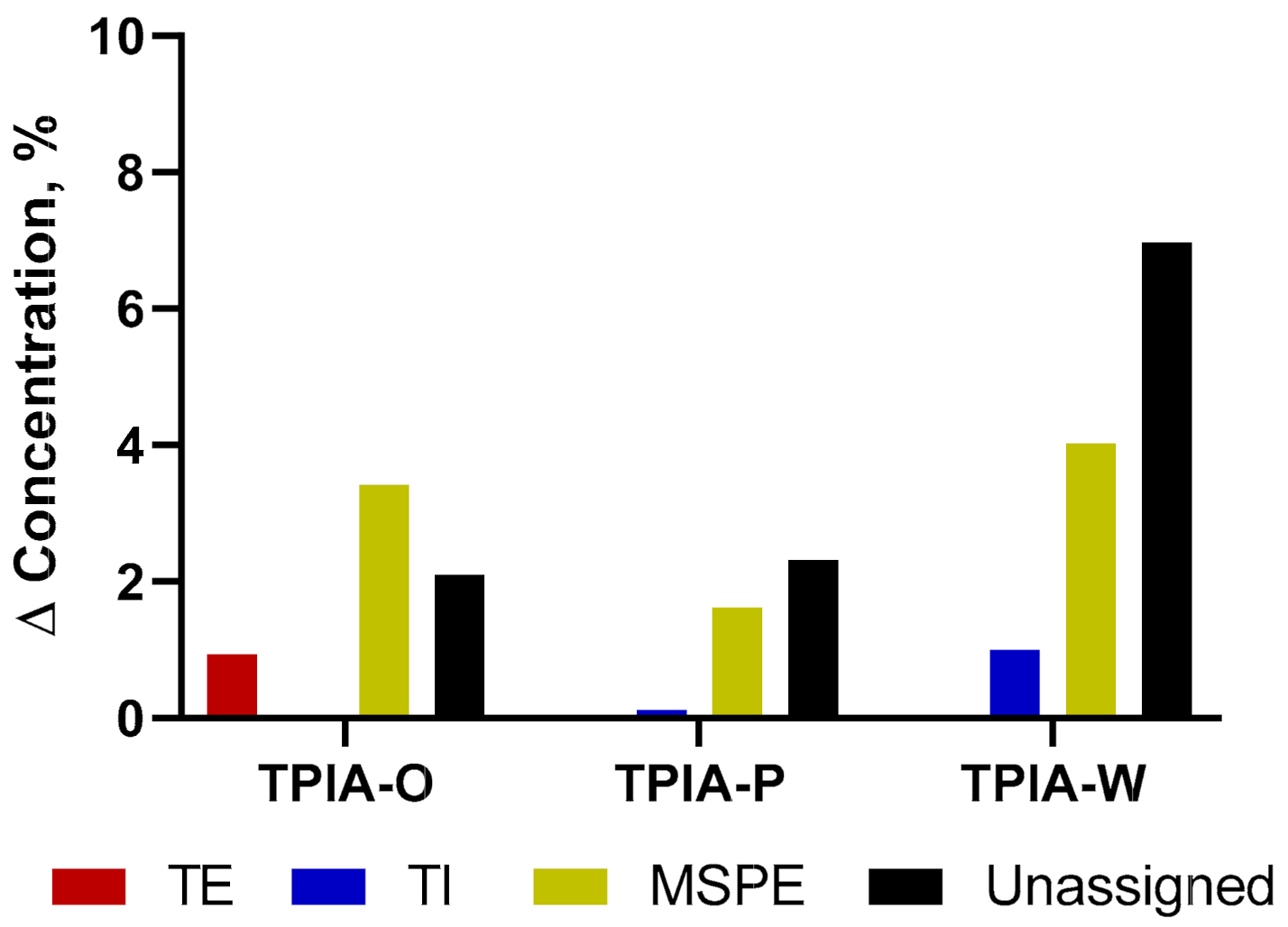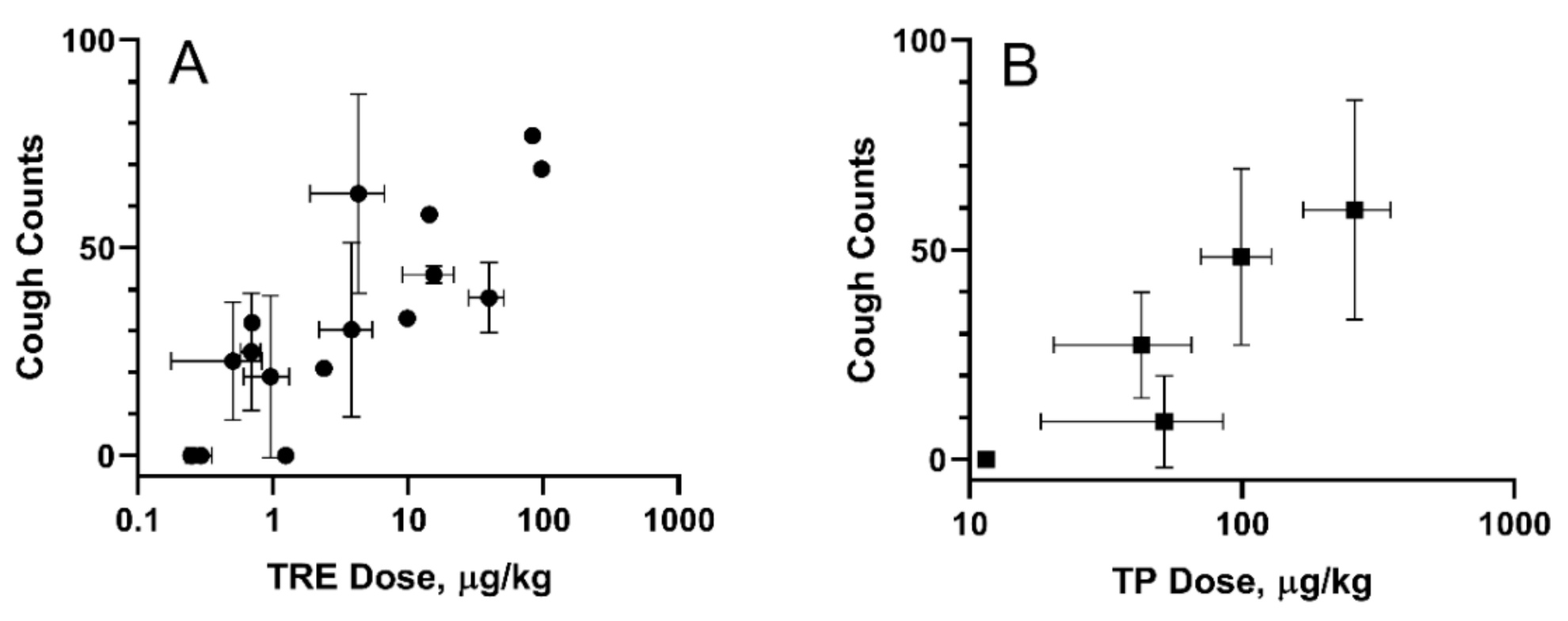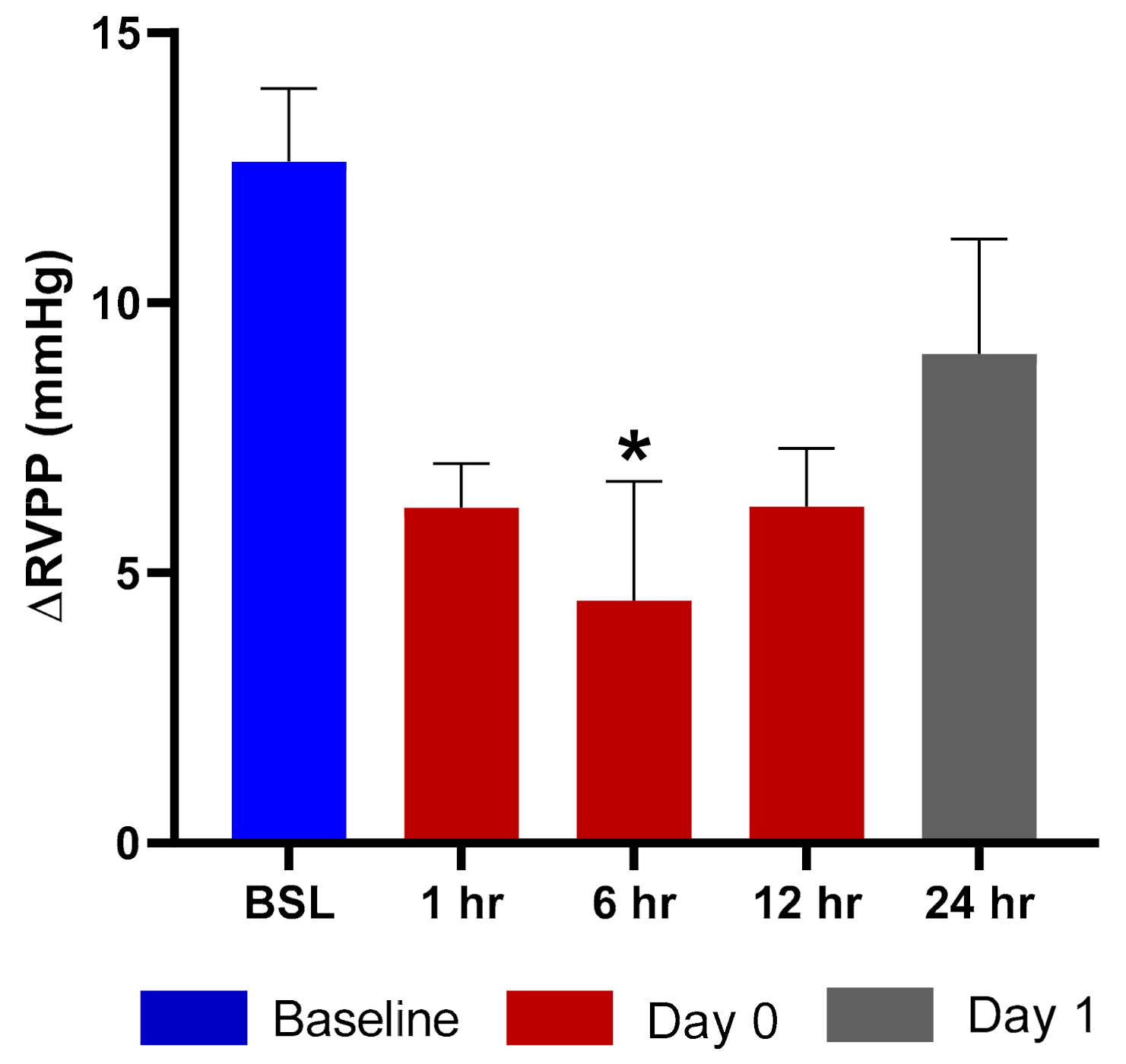Development and Characterization of Treprostinil Palmitil Inhalation Aerosol for the Investigational Treatment of Pulmonary Arterial Hypertension
Abstract
:1. Introduction
2. Results
2.1. Formulation Development
2.2. Aerosol Performance
2.3. Dose Through Use
2.4. Pharmacokinetic Studies
2.5. Cough Studies
2.6. Efficacy in a Rat Hypoxia Model
3. Discussion
3.1. Formulation
3.2. Solubility
3.3. Aerosol Performance
3.4. Pharmacokinetics
3.5. Cough
3.6. Efficacy
4. Materials and Methods
4.1. MDI Canisters
4.2. Solubility
4.3. Aerosol Performance
4.4. Dose through Use
4.5. Chemical Stability
4.6. Inhalation Studies
4.7. Pharmacokinetic Analysis
4.8. Dose Calculations
4.9. Cough Methods
4.10. Efficacy and PK Determinations
5. Conclusions
Supplementary Materials
Author Contributions
Funding
Institutional Review Board Statement
Informed Consent Statement
Data Availability Statement
Acknowledgments
Conflicts of Interest
Abbreviations
| API | Active Pharmaceutical Ingredient |
| APSD | Aerodynamic Particle Size Distribution |
| BSL | Baseline |
| BW | Body Weight |
| CAD | Charged Aerosol Detector |
| CF | Aerosol Concentration of the Filter |
| CL | Concentration of TP in the Lungs |
| D | Exposure Duration |
| DDU | Delivered Dose Uniformity |
| DF | Deposition Fraction |
| DSPE-PEG2000 | 1,2-distearoyl-sn-glycero-3-phosphoethanolamine-N-[amino(polyethylene glycol)-2000] |
| DUSA | Dose Uniformity Sample Apparatus |
| EtOH | Ethanol |
| FPD | Find Particle Dose |
| FPF | Fine Particle Fraction |
| GSD | Geometric Standard Deviation |
| HFAHPLC | HydrofluoroalkaneHigher-Performance Liquid Chromatography |
| IPA | Isopropyl Alcohol |
| JL | Jet Length |
| LW | Lung Weight |
| MMADMDI | Median Mass Aerodynamic DiameterMetered-Dose Inhaler |
| MS | Mass spectrometry |
| mSAP | Mean Systemic Arterial Blood Pressure |
| MSPE-PEG2000 | 2-stearoyl-sn-glycero-3-phosphoethanolamine-N-[amino(polyethylene glycol)-2000] |
| NGI | Next-Generation Impactor |
| OD | Orifice Diameter |
| PAH | Pulmonary Arterial Hypertension |
| PEG | Polyethylene Glycol |
| PET | Polyethylene Terephthalate |
| PG | Propylene Glycol |
| PK | Pharmacokinetics |
| PVC | Polyvinyl Chloride |
| RMV | Respiratory Minute Volume |
| RVPP | Right Ventricular Pulse Pressure |
| TCC | Total Can Content |
| TE | Treprostinil Ethyl |
| TI | Treprostinil Isopropyl |
| TP | Treprostinil Palmitil |
| TPeq | Treprostinil Palmitil Equivalents |
| TPIA | Treprostinil Palmitil Inhalation Aerosol |
| TRE | Treprostinil |
References
- LeVarge, B.L. Prostanoid therapies in the management of pulmonary arterial hypertension. Ther. Clin. Risk Manag. 2015, 11, 535–547. [Google Scholar]
- Majed, B.H.; Khalil, R.A. Molecular mechanisms regulating the vascular prostacyclin pathways and their adaptation during pregnancy and in the newborn. Pharmacol. Rev. 2012, 64, 540–582. [Google Scholar] [CrossRef] [PubMed] [Green Version]
- Tyvaso® (Treprostinil) [Package Insert]; United Therapeutics Corporation: Research Triangle Park, NC, USA, 2014.
- Orenitram® (Treprostinil) [Package Insert]; United Therapeutics Corporation: Research Triangle Park, NC, USA, 2014.
- Remodulin® (Treprostinil) [Package insert]; United Therapeutics Corporation: Research Triangle Park, NC, USA, 2014.
- Picken, C. Prodrug Approaches to Reduce Treprostinil Toxicity; UCL University College London: London, UK, 2019. [Google Scholar]
- Picken, C.; Laing, P.; Shen, L.; Clapp, L.H.; Brocchini, S. Synthetic routes to treprostinil n-acyl methylsulfonamide. Tetrahedron Lett. 2020, 61, 151428. [Google Scholar]
- Chen, K.-J.; Han, C. Extended release of inhaled liposomal treprostinil able to prolong and improve reduction of pulmonary arterial pressure in hypoxia-induced pulmonary hypertension rats. In C50. The Perfect Drug: Experimental Treatments of Pah; American Thoracic Society: New York, NY, USA, 2019; pp. A5056–A5056. [Google Scholar]
- Chen, K.-J.; Hsu, C.-F.; Lin, Y.-F. Inhaled liposomal treprostinil shows sustained pharmacokinetic profile, lower irritation, and potentials of reducing dosing frequency. In B59. Shoot the Curl: Splashing into Mechanisms of Endothelial Cell Function and Vascular Remodeling in Ph; American Thoracic Society: New York, NY, USA, 2018; p. A3753. [Google Scholar]
- Feldman, J.; Habib, N.; Fann, J.; Radosevich, J.J. Treprostinil in the treatment of pulmonary arterial hypertension. Future Cardiol. 2020. [Google Scholar] [CrossRef] [PubMed]
- Maynor, B.W.; Anderson, S.; Vaughn, T.; Brudi, P.; van Holsbeke, C.; Mussche, C.; Mignot, B.; Roscigno, R. Nonclinical, in silico, and clinical evaluation of liq861 inhalation powder deposition and pharmacokinetics. Digit. Respir. Drug Deliv. 2020, 2, 371–374. [Google Scholar]
- Roscigno, R.; Vaughn, T.; Hunt, T.; Parsley, E.; Eldon, M.; Rubin, L.J. Pharmacokinetic (pk) performance of liq861 and evaluation of comparative bioavailability with tyvaso® in healthy subjects (study lti-102). In Proceedings of the 14th Pulmonary Vascular Research Institute (PVRI) Annual World Congress on Pulmonary Vascular Disease, Lima, Peru, 31 January 2020. [Google Scholar]
- Voswinckel, R.; Reichenberger, F.; Gall, H.; Schmehl, T.; Gessler, T.; Schermuly, R.T.; Grimminger, F.; Rubin, L.J.; Seeger, W.; Ghofrani, H.A.; Olschewski, H. Metered dose inhaler delivery of treprostinil for the treatment of pulmonary hypertension. Pulm. Pharmacol. Ther. 2009, 22, 50–56. [Google Scholar] [CrossRef] [Green Version]
- Hill, N.S.; Feldman, J.P.; Sahay, S.; Levine, D.; Roscigno, R.F.; Vaughn, T.A.; Bull, T.M. Inspire: Final results from a phase 3, open-label, pivotal study to evaluate the safety and tolerability of liq861 in pulmonary arterial hypertension. J. Heart Lung Transplant. 2020, 39, S17–S18. [Google Scholar]
- Leifer, F.; Konicek, D.; Chen, K.-J.; Plaunt, A.; Salvail, D.; Laurent, C.; Corboz, M.; Li, Z.; Chapman, R.; Perkins, W.; et al. Inhaled treprostinil-prodrug lipid nanoparticle formulations provide long-acting pulmonary vasodilation. Drug Res. 2018, 68, 605–614. [Google Scholar] [CrossRef] [Green Version]
- Corboz, M.R.; Li, Z.; Malinin, V.; Plaunt, A.J.; Konicek, D.M.; Leifer, F.G.; Chen, K.J.; Laurent, C.E.; Yin, H.; Biernat, M.C.; Salvail, D.; Zhuang, J.; Xu, F.; Curran, A.; Perkins, W.R.; Chapman, R.W. Preclinical pharmacology and pharmacokinetics of inhaled hexadecyl-treprostinil (C16TR), a pulmonary vasodilator prodrug. J. Pharmacol. Exp. Ther. 2017, 363, 348–357. [Google Scholar] [CrossRef] [Green Version]
- Chapman, R.W.; Li, Z.; Corboz, M.R.; Gauani, H.; Plaunt, A.J.; Konicek, D.M.; Leifer, F.G.; Laurent, C.E.; Yin, H.; Salvail, D.; Dziak, C.; Perkins, W.R.; Malinin, V. Inhaled hexadecyl-treprostinil provides pulmonary vasodilator activity at significantly lower plasma concentrations than infused treprostinil. Pulm. Pharmacol. Ther. 2018, 49, 104–111. [Google Scholar] [CrossRef]
- Han, D.; Fernández, C.; Sullivan, E.; Xu, D.; Perkins, W.; Darwish, M.; Rubino, C. Single dose pharmacokinetics of C16TR for inhalation (INS1009) vs treprostinil inhalation solution. Eur. Respir. J. 2016, 48. [Google Scholar] [CrossRef]
- Han, D.; Fernandez, C.; Sullivan, E.; Xu, D.; Perkins, W.; Darwish, M.; Rubino, C. Safety and pharmacokinetics study of a single ascending dose of c16tr for inhalation (ins1009). Eur. Respir. J. 2016, 48, PA2403. [Google Scholar]
- Ibrahim, M.; Verma, R.; Garcia-Contreras, L. Inhalation drug delivery devices: Technology update. Med. Devices 2015, 8, 131–139. [Google Scholar]
- Zhu, B.; Traini, D.; Young, P. Aerosol particle generation from solution-based pressurized metered dose inhalers: A technical overview of parameters that influence respiratory deposition. Pharm. Dev. Technol. 2015, 20, 897–910. [Google Scholar] [CrossRef]
- Myrdal, P.B.; Sheth, P.; Stein, S.W. Advances in metered dose inhaler technology: Formulation development. AAPS PharmSciTech 2014, 15, 434–455. [Google Scholar] [CrossRef] [PubMed] [Green Version]
- Stein, S.W.; Sheth, P.; Hodson, P.D.; Myrdal, P.B. Advances in metered dose inhaler technology: Hardware development. AAPS PharmSciTech 2014, 15, 326–338. [Google Scholar] [CrossRef] [Green Version]
- Chapman, R.W.; Corboz, M.R.; Fernandez, C.; Sullivan, E.; Plaunt, A.J.; Konicek, D.M.; Malinin, V.; Li, Z.; Cipolla, D.; Perkins, W. Characterization of cough evoked by inhaled treprostinil and treprostinil palmitil. ERJ Open Res. 2020. [Google Scholar] [CrossRef]
- Werley, M.S.; McDonald, P.; Lilly, P.; Kirkpatrick, D.; Wallery, J.; Byron, P.; Venitz, J. Non-clinical safety and pharmacokinetic evaluations of propylene glycol aerosol in sprague-dawley rats and beagle dogs. Toxicology 2011, 287, 76–90. [Google Scholar]
- Montharu, J.; le Guellec, S.; Kittel, B.; Rabemampianina, Y.; Guillemain, J.; Gauthier, F.; Diot, P.; de Monte, M. Evaluation of lung tolerance of ethanol, propylene glycol, and sorbitan monooleate as solvents in medical aerosols. J. Aerosol Med. Pulm. Drug Deliv. 2010, 23, 41–46. [Google Scholar] [CrossRef]
- Sawatdee, S.; Hiranphan, P.; Laphanayos, K.; Srichana, T. Evaluation of sildenafil pressurized metered dose inhalers as a vasodilator in umbilical blood vessels of chicken egg embryos. Eur. J. Pharm. Biopharm. 2014, 86, 90–97. [Google Scholar] [CrossRef]
- Symbicort® (Budesonide and Formoteral Rumerate Dihydrate) [Package Insert]; AstraZeneca: Wilmington, DE, USA, 2006.
- Klonne, D.R.; Dodd, D.E.; Losco, P.E.; Troup, C.M.; Tyler, T.R. Two-week aerosol inhalation study on polyethylene glycol (peg) 3350 in f-344 rats. Drug Chem. Toxicol. 1989, 12, 39–48. [Google Scholar] [CrossRef] [PubMed]
- Pellegrini, J.; DeLoge, J.; Bennett, J.; Kelly, J. Comparison of inhalation of isopropyl alcohol vs promethazine in the treatment of postoperative nausea and vomiting (ponv) in patients identified as at high risk for developing ponv. Aana. J. 2009, 77, 293–299. [Google Scholar] [PubMed]
- Gauani, H.; Du, J.; Chun, D.; Baker, T.; Viramontes, V.; Plaunt, A.; Malinin, V.; Cipolla, D.C.; Perkins, W.R.; Li, Z. Aerosol performance and rat lung pharmacokinetics of a dry powder hexadecyl treprostinil (c16tr) formulation containing trehalose. RDD Eur. 2019, 2, 317–320. [Google Scholar]
- Chong, B.T.; Agrawal, D.K.; Romero, F.A.; Townley, R.G. Measurement of bronchoconstriction using whole-body plethysmograph: Comparison of freely moving versus restrained guinea pigs. J. Pharmacol. Toxicol. Methods 1998, 39, 163–168. [Google Scholar] [CrossRef]
- Lomask, M. Further exploration of the penh parameter. Exp. Toxicol. Pathol. 2006, 57 (Suppl. 2), 13–20. [Google Scholar] [CrossRef]
- Chapman, R.W.; Li, Z.; Chun, D.; Gauani, H.; Malinin, V.; Plaunt, A.J.; Cipolla, D.; Perkins, W.; Corboz, M.R. Treprostinil palmitil inhalation suspension (TPIS), a long-acting pulmonary vasodilator, does not show tachyphylaxis with daily dosing in rats. Pulm. Pharmacol. Ther. 2020, 66, 101983. [Google Scholar] [CrossRef]
- Zhang, Y.; Huo, M.; Zhou, J.; Xie, S. Pksolver: An add-in program for pharmacokinetic and pharmacodynamic data analysis in microsoft excel. Comput. Methods Programs Biomed. 2010, 99, 306–314. [Google Scholar] [CrossRef]
- Alexander, D.J.; Collins, C.J.; Coombs, D.W.; Gilkison, I.S.; Hardy, C.J.; Healey, G.; Karantabias, G.; Johnson, N.; Karlsson, A.; Kilgour, J.D.; McDonald, P. Association of inhalation toxicologists (ait) working party recommendation for standard delivered dose calculation and expression in non-clinical aerosol inhalation toxicology studies with pharmaceuticals. Inhal. Toxicol. 2008, 20, 1179–1189. [Google Scholar] [CrossRef]







| TPIA | Excipient 1 | Excipient 2 | Alcohol | Propellant | Composition (mg/mL) | Alcohol (wt %) | ||
|---|---|---|---|---|---|---|---|---|
| TP | Exc1 | Exc2 | ||||||
| TPIA-A | DSPE-PEG2000 | - | EtOH | HFA-134 | 1 | 0.5 | 0 | 9 |
| TPIA-C | DSPE-PEG2000 | PEG400 | EtOH | HFA-227 | 0.5 | 0.25 | 0.75 | 5 |
| TPIA-E | DSPE-PEG2000 | - | EtOH | HFA-227 | 3 | 3 | 0 | 10 |
| TPIA-H | DSPE-PEG2000 | PG | EtOH | HFA-227 | 1 | 0.5 | 1.5 | 3 |
| TPIA-I | DSPE-PEG2000 | PEG1000 | EtOH | HFA-227 | 1 | 0.5 | 3 | 3 |
| TPIA-J | DSG-PEG2000 | PEG400 | EtOH | HFA-227 | 0.5 | 0.25 | 3 | 5 |
| TPIA-K | DPG-PEG2000 | PEG400 | EtOH | HFA-227 | 0.5 | 0.25 | 3 | 5 |
| TPIA-L | DSPE-PEG2000 | PEG400 | EtOH | HFA-227 | 0.5 | 0.25 | 3 | 5 |
| TPIA-O | DSPE-PEG2000 | PEG400 | EtOH | HFA-227 | 1 | 0.5 | 6 | 7 |
| TPIA-P | DSPE-PEG2000 | PEG400 | IPA | HFA-227 | 1 | 0.5 | 6 | 7 |
| TPIA-S | Brij-58 | PEG400 | EtOH | HFA-227 | 1 | 0.5 | 6 | 5 |
| TPAI-T | Brij-58 | PEG400 | IPA | HFA-134 | 1 | 0.5 | 3 | 7 |
| TPIA-W | DSPE-PEG2000 | PEG400 | IPA | HFA-134 | 1 | 0.5 | 3 | 10 |
| TPAI-X | DSPE-PEG2000 1 | PEG400 | IPA | HFA-134 | 1 | 0.5 | 3 | 10 |
| Jet Length (mm) | Orifice Diameter (mm) | MMAD (µm) | Fine Particle Fraction (%) | Fine Particle Fraction (%) | |||
|---|---|---|---|---|---|---|---|
| Mean | SD | Mean | SD | Mean | SD | ||
| 0.30 | 0.7 | 1.69 | 0.04 | 33.5 | 2.3 | 14.7 | 0.69 |
| 0.27 | 0.5 | 1.72 | 0.04 | 56.1 | 0.9 | 25.7 | 1.48 |
| 0.25 | 0.5 | 1.61 | 0.1 | 61.8 | 3.6 | 27.5 | 0.41 |
| 0.2 | 0.5 | 1.54 | 0.03 | 74.2 | 0.9 | 34.9 | 1.28 |
| Test Article | TP Delivered Dose (µg/kg) | Lung TPeq Cmax (ng/g) | Lung TPeq AUC0-24 (µg·h/g) | Lung TPeq T1/2 (h) | Plasma Cmax (ng/mL) | Plasma TRE AUC0-24 (ng·h/mL) | Plasma TRE T1/2 (h) |
|---|---|---|---|---|---|---|---|
| TPIS | 108 | 24700 | 17.9 | 4.9 | 2.79 | 20.97 | 5.8 |
| TPIA-A | 10.8 | 765 | 9.5 | 15 | NC1 | NC1 | NC1 |
| TPIA-E | 29.9 | 1430 | 12.9 | 9.14 | 0.14 | 1.32 | 7.8 |
| TPIA-H | 67.3 | 3080 | 36.2 | 10.2 | 0.22 | 2.23 | 4.7 |
| TPIA-I | 66.8 | 1670 | 19.4 | 10.8 | 0.33 | 2.54 | 3.2 |
| TPIA-J | 12.1 | 438 | 3.5 | 5.59 | 0.07 | 0.28 | 4.9 |
| TPIA-K | 26.4 | 436 | 4.2 | 5.8 | 0.95 | 1.46 | 2.5 |
| TPIA-L | 13.2 | 1190 | 11.2 | 6.05 | NC | NC | NC |
| TPIA-S | 12.5 | 237 | 2.01 | 4.67 | NC | NC | NC |
| TPIA-W | 115 | 2440 | 36.8 | 11.3 | 0.5 | 4.53 | 7.1 |
| 62.2 | 1040 | 9.5 | 8.01 | 0.25 | 1.84 | 8.5 | |
| TPIA-X | 111 | 1850 | 16.9 | 7.99 | 0.42 | 3.6 | 3.9 |
Publisher’s Note: MDPI stays neutral with regard to jurisdictional claims in published maps and institutional affiliations. |
© 2021 by the authors. Licensee MDPI, Basel, Switzerland. This article is an open access article distributed under the terms and conditions of the Creative Commons Attribution (CC BY) license (http://creativecommons.org/licenses/by/4.0/).
Share and Cite
Plaunt, A.J.; Islam, S.; Macaluso, T.; Gauani, H.; Baker, T.; Chun, D.; Viramontes, V.; Chang, C.; Corboz, M.R.; Chapman, R.W.; et al. Development and Characterization of Treprostinil Palmitil Inhalation Aerosol for the Investigational Treatment of Pulmonary Arterial Hypertension. Int. J. Mol. Sci. 2021, 22, 548. https://doi.org/10.3390/ijms22020548
Plaunt AJ, Islam S, Macaluso T, Gauani H, Baker T, Chun D, Viramontes V, Chang C, Corboz MR, Chapman RW, et al. Development and Characterization of Treprostinil Palmitil Inhalation Aerosol for the Investigational Treatment of Pulmonary Arterial Hypertension. International Journal of Molecular Sciences. 2021; 22(2):548. https://doi.org/10.3390/ijms22020548
Chicago/Turabian StylePlaunt, Adam J., Sadikul Islam, Tony Macaluso, Helena Gauani, Thomas Baker, Donald Chun, Veronica Viramontes, Christina Chang, Michel R. Corboz, Richard W. Chapman, and et al. 2021. "Development and Characterization of Treprostinil Palmitil Inhalation Aerosol for the Investigational Treatment of Pulmonary Arterial Hypertension" International Journal of Molecular Sciences 22, no. 2: 548. https://doi.org/10.3390/ijms22020548
APA StylePlaunt, A. J., Islam, S., Macaluso, T., Gauani, H., Baker, T., Chun, D., Viramontes, V., Chang, C., Corboz, M. R., Chapman, R. W., Li, Z., Cipolla, D. C., Perkins, W. R., & Malinin, V. S. (2021). Development and Characterization of Treprostinil Palmitil Inhalation Aerosol for the Investigational Treatment of Pulmonary Arterial Hypertension. International Journal of Molecular Sciences, 22(2), 548. https://doi.org/10.3390/ijms22020548






